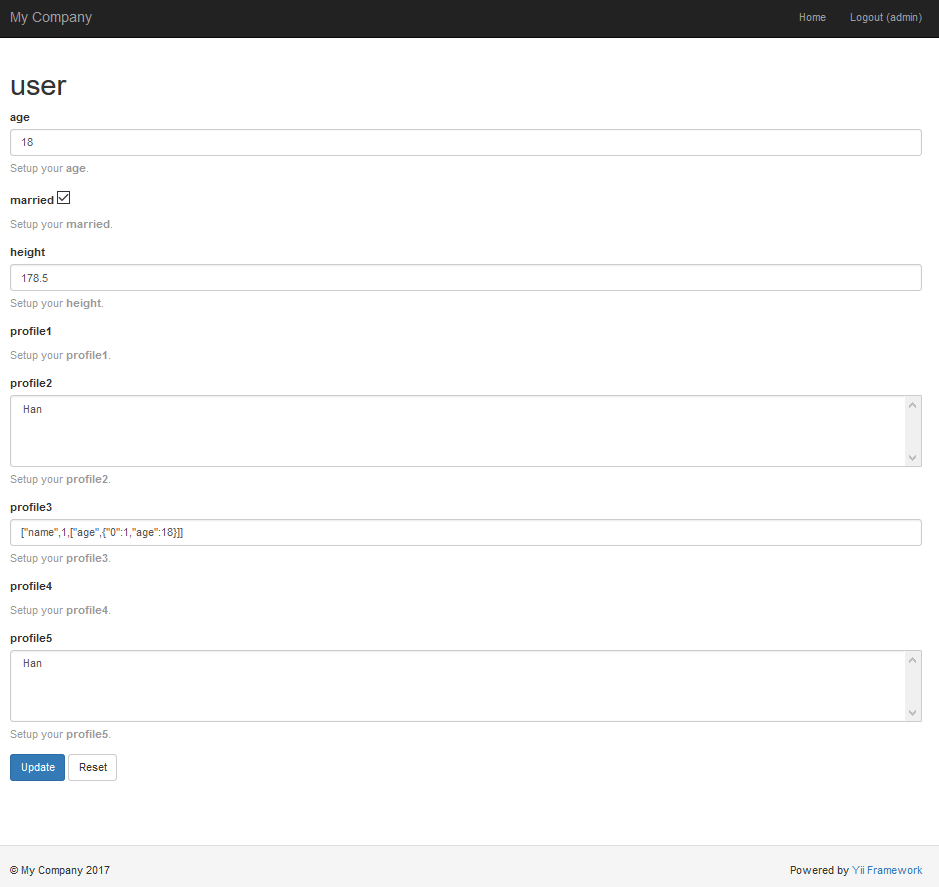yongtiger / yii2-setting
Simple and efficient setup. All settings are read from DB or cache into a static array at frontend. Updates specified setting category at backend.
Installs: 27
Dependents: 1
Suggesters: 0
Security: 0
Stars: 1
Watchers: 1
Forks: 0
Open Issues: 0
Type:yii2-extension
pkg:composer/yongtiger/yii2-setting
Requires
- php: >=5.5
- yiisoft/yii2: *
- yiisoft/yii2-bootstrap: *
This package is not auto-updated.
Last update: 2025-12-07 02:36:25 UTC
README
Simple and efficient setup. All settings are read from DB or cache into a static array at frontend. Updates specified setting category at backend.
FEATURES
- frontend and backend codes completely separated
- settings pre-stored in DB
- categorized settings
- simple API for frontend read
- displaying all setting items of the specified category by URL route
- displaying a setting item according to the specified input field type
DEPENDENCES
INSTALLATION
The preferred way to install this extension is through composer.
Either run
php composer.phar require --prefer-dist yongtiger/yii2-setting "*"
or add
"yongtiger/yii2-setting": "*"
to the require section of your composer.json.
CONFIGURATION
Database migrations and customize settings
Before usage this extension, you need to prepare the database.
1. Create setting table
php yii migrate --migrationPath=@vendor/yongtiger/yii2-setting/src/migrations
2. Customize settings
You need to modify the records in the setting table by any SQL query tools, such as phpmysqladmin.
Refer to
demo settings in DBandUsages.
Backend setup
1. Module setup
To access the module in backend, you need to configure the modules array in your application configuration:
'modules' => [ // ... 'setting' => [ 'class' => 'yongtiger\setting\Module', ], // ... ],
2. Internationalization setup (optional)
All text and messages introduced in this extension (NOT include the settings in DB!) are translatable under category:
'extensions/yongtiger/yii2-setting/*'
And the default basePath is '@vendor/yongtiger/yii2-setting/src/messages'.
If you want to custumize your own translations, using following application configuration:
return [ 'components' => [ 'i18n' => [ 'translations' => [ 'extensions/yongtiger/yii2-setting/*' => [ 'class' => 'yii\i18n\PhpMessageSource', 'sourceLanguage' => 'en-US', 'basePath' => '<your custumized message path>', ///custumize your own translations 'fileMap' => [ 'extensions/yongtiger/yii2-setting/setting' => 'settings.php', ], ], // ... ], ], // ... ], // ... ];
USAGE IN FRONTEND
Note: Only
category,key,valueandtypefields in the setting table are used in the frontend.
Use function Setting::get($category, $key, $default = null) to get a setting directly (no need frontend setup):
$mySetting = \yongtiger\setting\Setting::get('site', 'name');
The return value has been automatically converted to the type defined in the setting type.
See more about setting type:
Using default value
///Default value $mySetting = \yongtiger\setting\Setting::get('not-exist-category', 'not-exist-name', 'default-value'); ///Return 'default-value' if no exist setting category or key
Note: It is recommended that
default valuebe set to define the type in thesetting type.
Using setting array
In frontend, while getting any setting for the first time, all settings are read from DB or cache into a static array. Later, you can read a setting from the static array.
$mySettingArray = \yongtiger\setting\Setting::setting; ///get the current setting array \yongtiger\setting\Setting::setting = $mySettingArray; ///dynamically set a setting array
Using caching:
Default caching is enabled.
Sometimes you need to disable the cache (e.g. in testing):
\yongtiger\setting\Setting::enableCaching = false; ///disable caching $mySetting = \yongtiger\setting\Setting::get('site', 'name');
USAGE IN BACKEND
You can access or update setting page by given the specified category:
http://<path-to>/index.php?r=setting/default/update&category=<category>
See more advanced settings:
TODO
Development roadmap
LICENSE
Yii2-setting is released under the MIT license, see LICENSE file for details.

